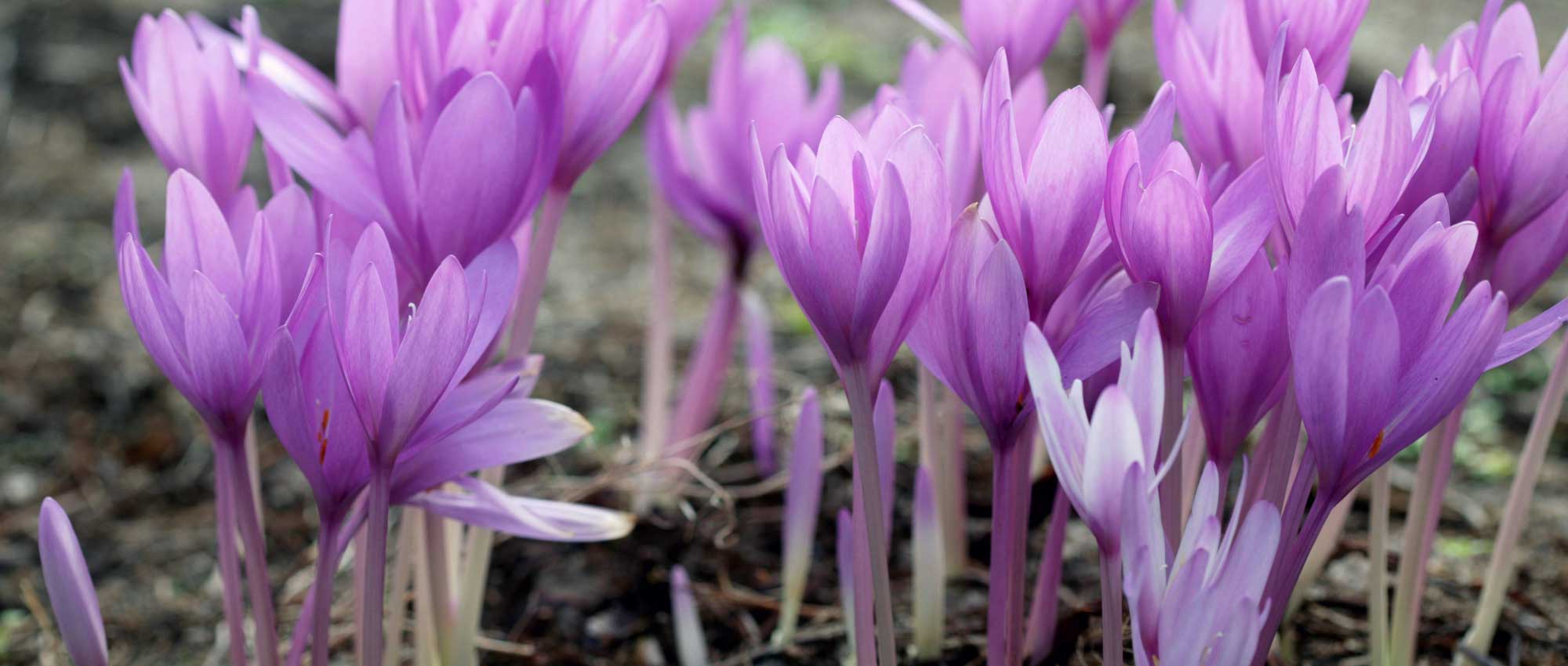
Colchicum: growing, planting and care
Contents
Colchicums in a nutshell
- Colchicums are bulbous plants that brighten up autumn and signal the end of summer!
- Easy to grow, they require no maintenance and tend to naturalise.
- We appreciate their elegant and soft flowering, in shades of mauve, pink, or white.
- They bear leaves in spring that disappear in summer, then produce delicate cup-shaped flowers in autumn.
- The flowers are often single, but can also be double like the waterlily colchicums.
A word from our Expert
Colchicum is a small perennial that flowers in late season. It closely resembles crocuses but blooms in autumn, as the famous song says: “Colchic in the meadows, it’s the end of summer.” Large flowers then appear, emerging directly from the soil. Like crocuses, they bear cup-shaped flowers that face upwards, in shades of mauve, purple, pink, or white. There are many species of colchicum, but the most common is Colchicum autumnale, the autumn colchicum. Although the flowers are often single, some varieties with double flowers, composed of many petals, can be found!
Colchicums also have corms, underground storage organs that resemble bulbs. The colchicum flowers bloom in autumn, then fade, and the leaves and fruits appear in spring, after which the plant enters dormancy for the summer… and will bloom again the following autumn!
This is an easy-to-cultivate and low-maintenance plant. It is ideal for adding a touch of colour at the end of summer, marking the end of the beautiful season in the garden. Colchicum requires no maintenance and can naturalise. It is perfect in short grass meadows, rockeries, in light woodland, at the foot of deciduous trees, or even in pots or containers!
Description and botany
Botanical data
- Latin name Colchicum sp.
- Family Colchicaceae
- Common name Colchicum
- Flowering between September and November
- Height 10 to 15 cm
- Exposure preferably in full sun, possibly in partial shade
- Soil type cool, well-drained
- Hardiness -15 to -20 °C
The colchicums are perennial plants with corms that resemble crocuses but bloom in autumn. They are found in Europe, Asia Minor and Central Asia, around the Mediterranean and into North Africa. Many species are encountered in Asia Minor and the Balkans (Turkey, Greece, Iran, Caucasus…). Colchicum autumnale is found in the wild in France, particularly in wet meadows.
There are just over a hundred species of colchicums. Their identification can be difficult as the flowers and leaves are not visible at the same time. Various botanical species are cultivated (Colchicum byzantinum, Colchicum speciosum…), but the most common are Colchicum autumnale and the varieties derived from it. France has about ten species in the wild. Again, the most widespread is the autumn colchicum. It is protected in several French regions (picking or destroying it is prohibited).
Colchicums have given their name to the family of Colchicaceae, a relatively recent family, as they were previously classified among the Liliaceae. Despite their resemblance to crocuses, these two plants do not belong to the same family. The Colchicaceae include, among others, the stunning Gloriosa superba (Glory Lily) and Sandersonia (Chinese Lantern).
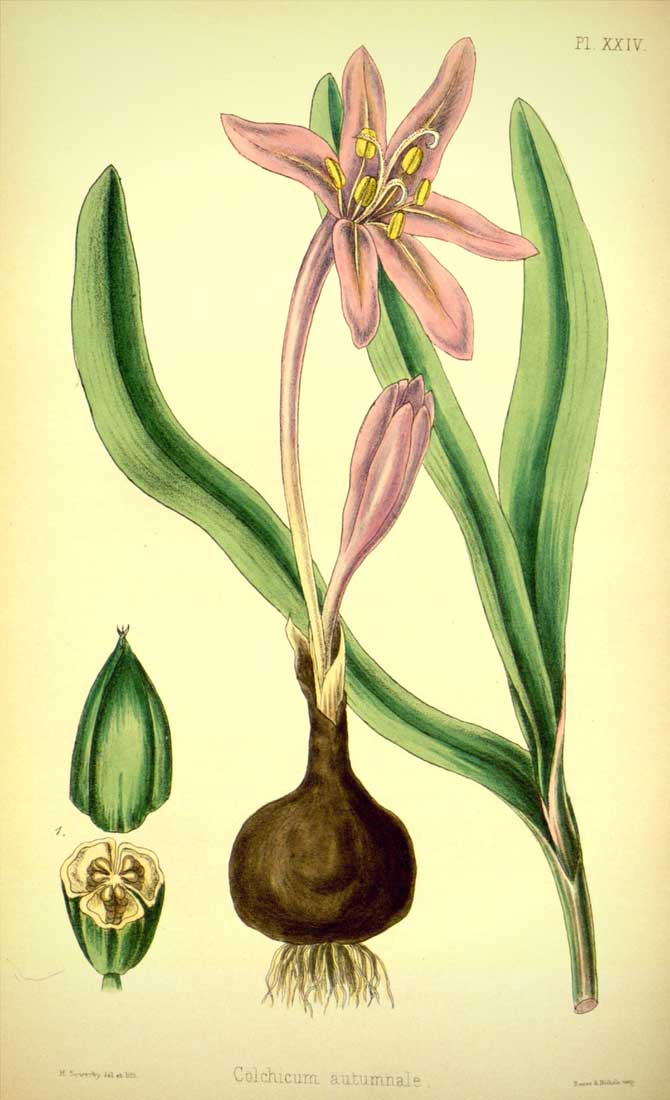
Colchicum autumnale: botanical illustration
The colchicum gets its name from Colchis, a region in Georgia, east of the Black Sea, from where it is thought to originate. In Greek mythology, it is also the realm of the sorceress Medea. The colchicum also has various common names: Meadow Saffron, Autumn Crocus, Dog’s Poison, Bastard Saffron…
Colchicums are small, relatively low plants that bloom close to the ground. They often measure between 10 and 15 cm in height, although some smaller species (5 cm) or taller ones can be found. The variety ‘The Giant’ is one of the tallest (up to 20 cm). Colchicums grow quite quickly.
The colchicum blooms in autumn, between September and November. There are also colchicums that bloom in spring or summer. The Colchicum hungaricum, kesselringii and luteum have the unique characteristic of blooming in winter (between January and March)! As for Colchicum bulbocodium, it blooms in spring.
The flowers appear at ground level and are not borne on a stem (only by a long tube, the extension of the petals). They are truly highlighted, as the leaves are not present at the same time and cannot therefore hide them! Generally, a bulb produces between one and six flowers… or even up to 20 flowers in the case of Colchicum byzantinum! The flower of the colchicum closely resembles that of the crocus: it is cup-shaped, located at ground level and facing upwards. Although the flowers are often single, they can also be double (with several rows of petals), as seen in the variety ‘Waterlily’. These double varieties are sometimes referred to as “Waterlily colchicums”.
The flowers are unfortunately quite fragile and are often damaged by rain. They can tend to flop over under their own weight or due to wind or rain.
Colchicums have pink, mauve or white flowers… with the exception of Colchicum luteum, whose flowers are golden yellow! The flowers are often lighter in the centre. Some species have maculate petals, with spots forming a checkerboard pattern, as seen in Colchicum agrippinum or Colchicum variegatum.
The flowers consist of three petals and three sepals, all having the same appearance. They are therefore referred to as tepals. They are fused and often measure 5 cm long. The flowers are hermaphroditic, containing both male and female organs. They have six stamens (three of which are longer) and three styles. This distinguishes them from crocuses, which only have three stamens and one style. The stamens are yellow or orange, adding a bit more brightness to the flower! The tepals are fused at the base into a long, thin tube, often white. The colchicum has the particularity of having its ovary remaining underground, at the bottom of the floral tube.

The flowering of colchicums: Colchicum ‘The Giant’ (photo Leontine Trijber – iBulb), Colchicum autumnale ‘Album’ and Colchicum ‘Waterlily’
The leaves develop in early spring. They allow the bulb to perform photosynthesis to store nutrients in the corm underground. They then wither, and the plant enters dormancy for the summer.
Colchicums bear between 3 and 6 elongated and relatively broad leaves. These measure between 10 and 30 centimetres long, reaching up to 40 cm for the Colchicum macrophyllum (whose name literally means “large-leaved”). They are green in colour and relatively shiny, like varnished. They are placed all around a short upright stem that they sheathe (sheathing leaves).
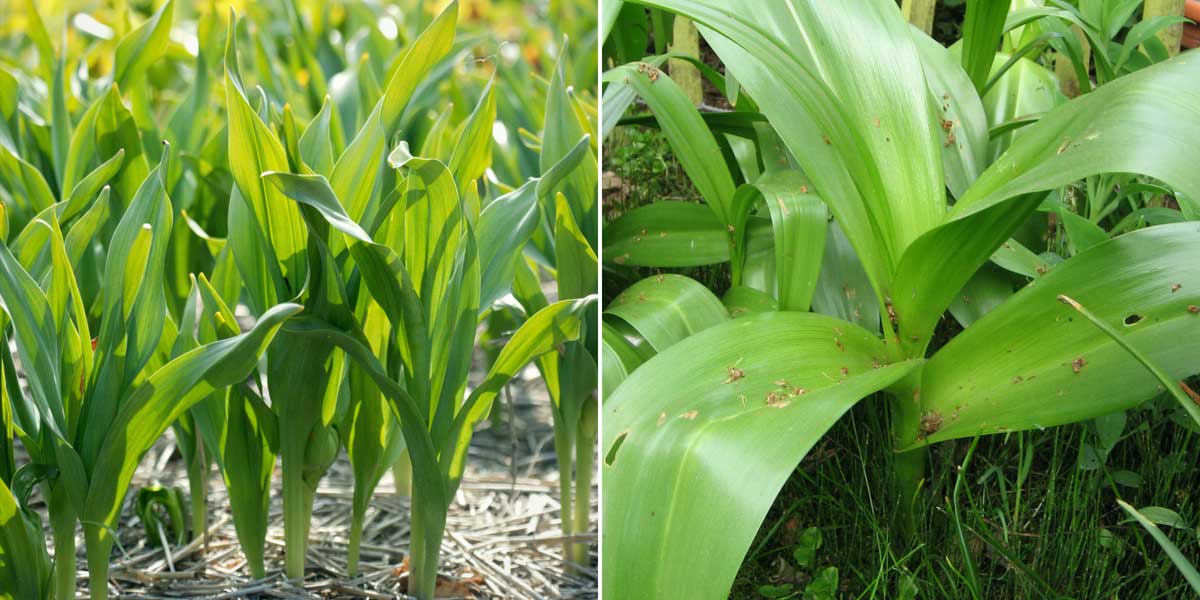
The foliage of colchicums in spring (photo Leontine Trijber – iBulb / photo Meneerke bloem)
The fruit of the colchicum appears in spring, between April and June, nestled among the leaves. It is a large, oblong capsule, relatively elongated. It opens when ripe to release brown seeds.
The colchicum is often considered a bulb, although it is actually a corm: a swollen stem located underground and surrounded by scales (modified leaves). It allows the plant to store nutrients. The colchicum is purchased and planted in the form of a corm.
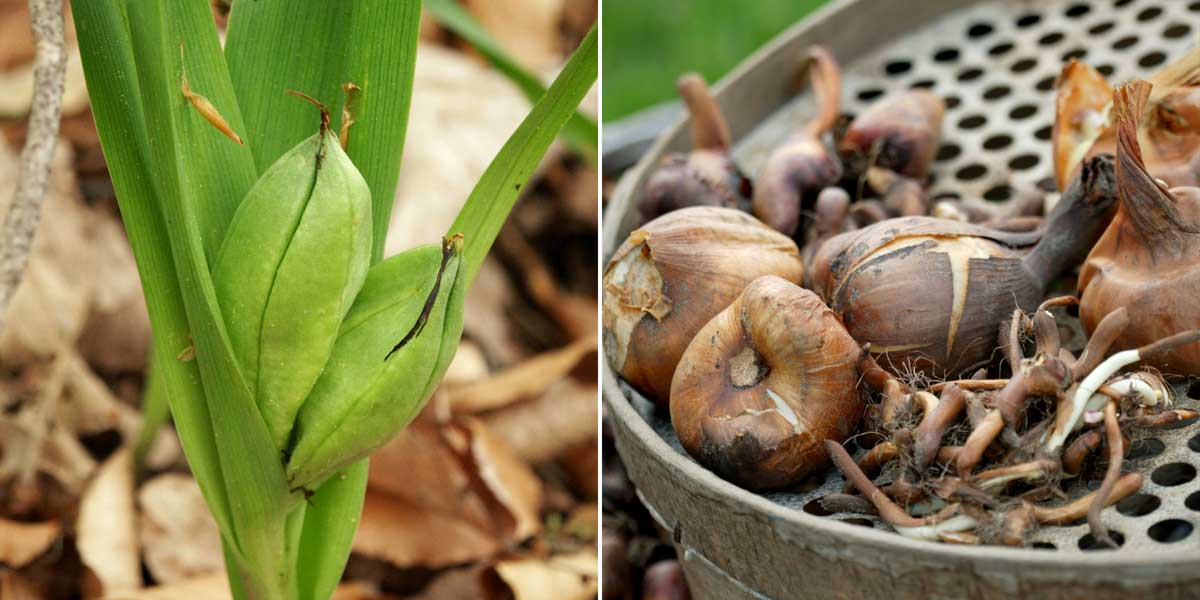
The fruits of the colchicum (photo BerndH) / the corms (photo Leontine Trijber – iBulb)
Thus, the colchicum has a somewhat unique cycle, in two stages: it blooms in autumn, then withers. At the beginning of spring, the leaves appear, followed by the fruits and seeds… Then everything disappears at the end of spring. The plant enters dormancy for the summer and will bloom again in autumn. It thus becomes forgotten for a large part of the year, although it remains present underground in the form of a corm.
The main varieties of colchicums

Colchicum autumnale Alboplenum - Autumn crocus
- Flowering time November
- Height at maturity 15 cm
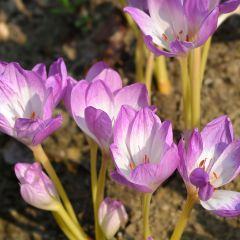
Colchique Hybride The Giant
- Flowering time November
- Height at maturity 20 cm
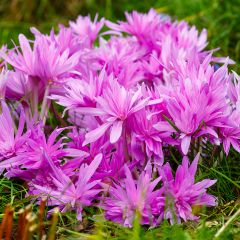
Colchicum automnale Waterlily
- Flowering time November
- Height at maturity 12 cm
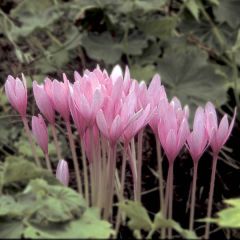
Colchicum Autumnale Major - Autumn crocus
- Flowering time October
- Height at maturity 12 cm
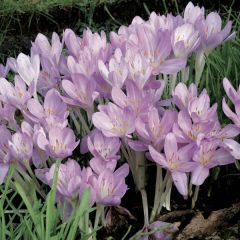
Colchicum cilicicum - Autumn Crocus
- Flowering time October, November
- Height at maturity 15 cm
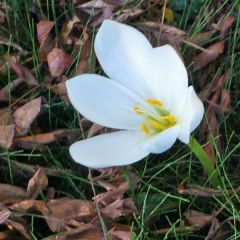
Colchicum speciosum Album - Autumn crocus
- Flowering time November
- Height at maturity 20 cm

Colchicum speciosum Atrorubens - Autumn crocus
- Flowering time November
- Height at maturity 20 cm
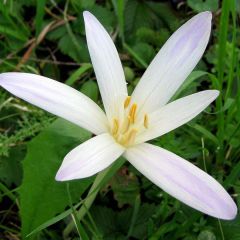
Colchicum autumnale Album - Autumn crocus
- Flowering time October, November
- Height at maturity 15 cm
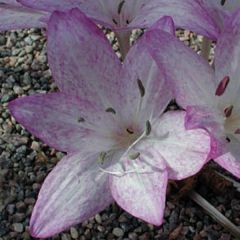
Colchicum macrophyllum - Autumn crocus
- Flowering time October to December
- Height at maturity 15 cm
Discover other Colchicum
View all →Available in 0 sizes
Available in 0 sizes
Available in 2 sizes
Available in 1 sizes
Available in 1 sizes
Available in 1 sizes
Available in 1 sizes
Available in 1 sizes
Available in 1 sizes
Available in 1 sizes
Planting colchicums
Where to plant?
Colchicums thrive in full sun. They require good light to produce well-developed flowers. You can optionally place them in partial shade or at the base of deciduous trees, but ensure they receive enough light.
Colchicums are not very demanding; they grow in rather ordinary soils. However, they prefer fertile, fairly rich organic matter, and deep soils. You can enrich your soil with some well-decomposed compost. As they are sometimes found in the wild in wet meadows, colchicums appreciate cool, yet well-draining soils.
It is better to place them in a sheltered location from wind and heavy rain, as these could damage the flowers. In any case, it may happen that the flowers of some varieties droop, sometimes under their own weight. In this case, it would be beneficial to support them between fairly rigid plants that will hold them up.
Colchicums will easily find their place in a short grass meadow, a flowerbed, a rockery, or in woodland… They may even naturalise there! Place them alongside other plants with autumn flowering. However, avoid grouping them in large numbers at the front of a flowerbed, as in spring, the foliage is not very decorative (it is better to use small flowering perennials instead), and becomes unsightly when it starts to yellow. You can, however, scatter them throughout a flowerbed or place them next to other blooms that will attract attention in spring.
You can also to grow the colchicum in a pot! This will allow you to place it, for example, on a terrace or balcony, creating a composition with autumn-flowering perennials or decorative foliage. As for Colchicum byzantinum, it has the unique ability to flower even without substrate or water, simply placed on a windowsill!
Most colchicums are quite hardy plants; they particularly enjoy regions with cold winters.
When to plant?
The best time to plant colchicums is at the end of summer, from July until September, or even October.
Plant the corms preferably as soon as you purchase them, without delay, otherwise they may flower before being in the ground! Similarly, when you divide them, replant them immediately.
How to plant?
We recommend planting colchicums in small groups rather than individually (unless scattering them in the same flowerbed). Gather at least 5 bulbs each time, and maintain a planting distance of 10 to 15 cm between the bulbs.
You can either plant them individually, digging a hole for each bulb and using a dibber if necessary, or dig a wide hole and plant them all together.
- Dig a planting hole. Feel free to add coarse sand to make the soil more draining, and possibly a bit of potting soil.
- Place the corm, point facing upwards, 10 to 15 cm deep.
- Cover with soil, then lightly firm down.
After planting, the corms do not need to be watered. It is always advisable to place a marker (for example, a small stake) to remember where you planted them and avoid damaging them if you intervene at another time in the same flowerbed.
To keep it simple, the colchicum byzantinum can flower without soil and without water! You actually don’t even need to plant it. Just place it in a dish in a bright spot.
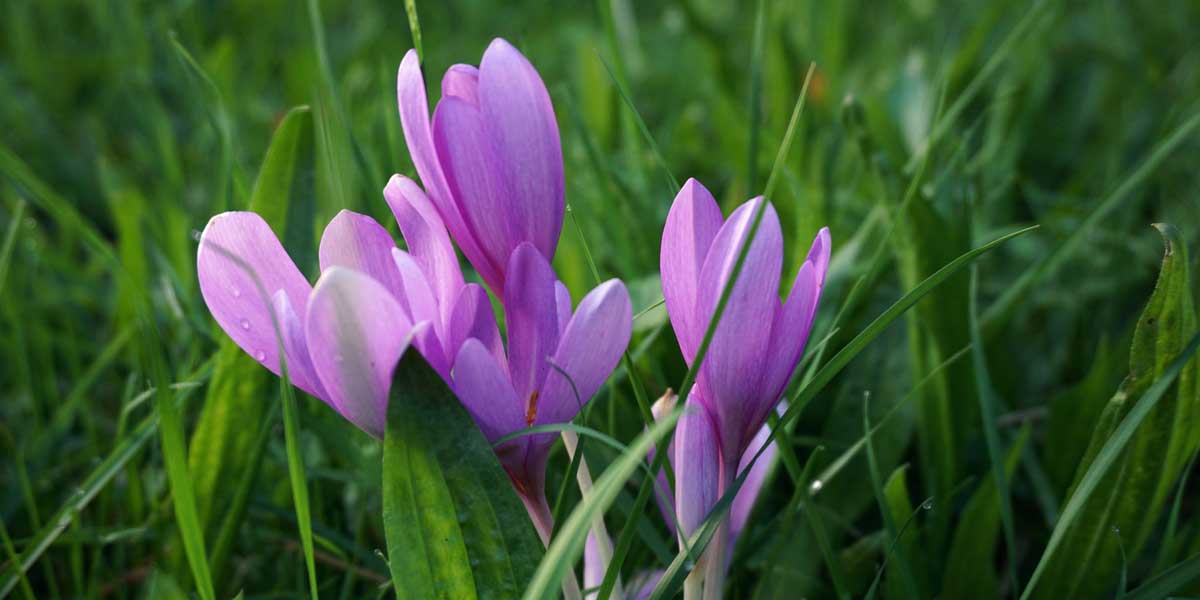
Care
Colchicums do not really require maintenance. Once established, they manage on their own! The ideal approach is to leave the bulbs undisturbed. They reappear each year and tend to naturalise! You may water them in case of severe drought; but generally, colchicums do very well without watering.
In spring, avoid cutting the leaves, even when they start to yellow. They should be allowed to wither naturally as they enable the bulb to build up nutrient reserves.
Colchicum is quite resistant to diseases. You may occasionally encounter problems with Botrytis, a fungal disease also known as grey mould, which is encouraged by excess moisture. It can also happen that slugs nibble on the foliage in spring.
Multiplication
Colchicum tends to thrive and spread naturally, without intervention. It is common for it to self-seed. In this case, you can collect the young plants to replant them elsewhere in the garden. You can also sow the seeds yourself. However, if you wish to multiply it, for example to install it in another location or to give away, we recommend division, a technique that is easier and quicker than sowing.
Division of corms
You can divide colchicum approximately every four years, in summer, around July, when it is still in dormancy.
Start by locating a fairly dense clump, then carefully dig up the corms. Separate them to keep only the largest ones. Replant them immediately in a new location. It is important to avoid them drying out by being left too long in the open air.
Garden association
With their late flowering, colchicums will allow you to create a stunning autumn scene! Pair them with other late-season flowers: with dahlias, asters, Echinacea purpurea, Japanese anemones, Eupatorium maculatum, Sedum spectabile, or Persicaria amplexicaulis… Opt for shades of purple, red, orange, and pink: soft and warm tones all at once! You can also combine colchicums with other autumn bulbs, such as saffron, Crocus sativus, which blooms at the same time and in similar hues. Not to mention nerines, crinums, or the yellow flowers of Sternbergia lutea, also known as autumn crocus.
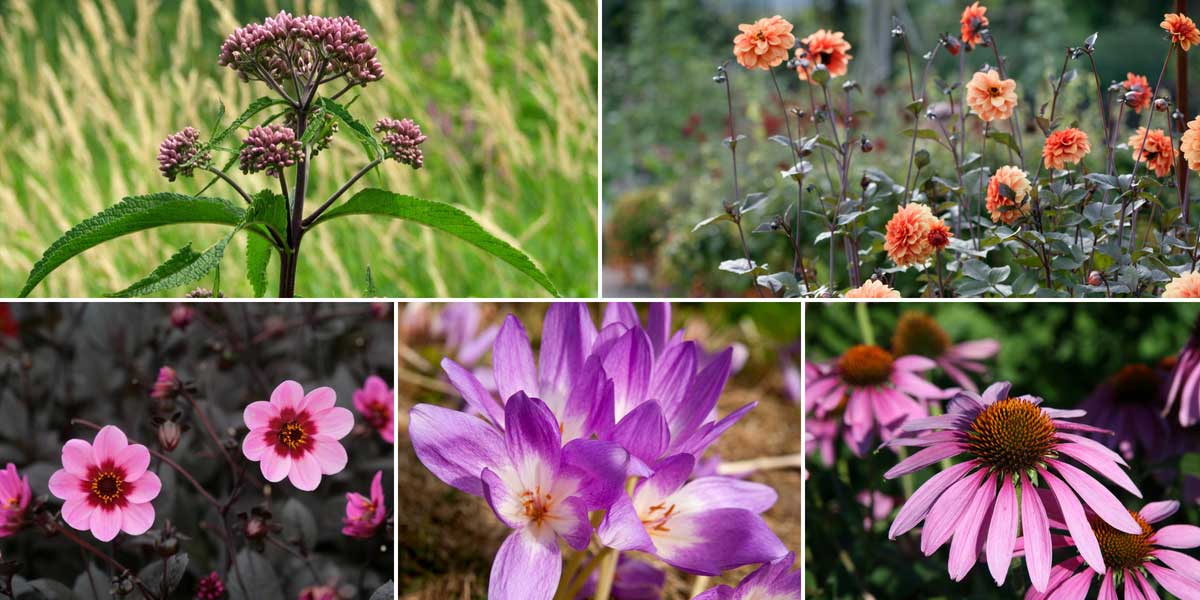
An idea for pairing with colchicums for a beautiful autumn scene. Eupatorium maculatum (photo D. Gordon E. Robertson), Dahlia ‘David Howard’ (photo Leontine Trijber – iBulb), Dahlia ‘Happy Single Wink’, Colchicum ‘Lilac Wonder’ (photo Wouter Koppen – iBulb) and Echinacea purpurea (photo Daniel Schwen)
You can pair them with colourful foliage! Autumn is the season when leaves take on beautiful hues, so it would be a shame not to take advantage of it! Also consider decorative fruits, such as those from the snowberry or callicarpa, whose colours will easily complement the flowering of colchicums.
For a poetic and light touch, enjoy the spikes of ornamental grasses, which catch the sun’s rays and can offer beautiful golden or silver reflections: Pennisetum, Miscanthus, Stipa…
Colchicums are perfect in the middle of a short grass meadow: you can scatter them and allow them to naturalise! You may accompany them with other small flowers, such as those of Sternbergia lutea, or mix different varieties of colchicums.
Colchicums will also find their place under deciduous trees, provided there is good light. You can plant them in a not too dense, fairly open undergrowth. You will achieve a very natural scene! Place them alongside ferns, Tricyrtis, Naples cyclamens…
As colchicum flowers sometimes tend to droop, you can plant them among low ground covers, which will help keep their flowers upright.
Colchicums can also be planted in a rockery, among other small creeping or cushion plants. They can follow earlier flowering rockery bulbs.
They also adapt well to pot or container planting, for example with Naples cyclamens or nerines. Place them among foliage, such as that of small grasses (Pennisetum compact, Carex…) muehlenbeckia or ivy.
Useful resources
- Discover our range of colchicums!
- An inspiration source for pairing colchicums: Autumn Atmosphere
- An article by Pascal on our blog – Flowering the Garden in Autumn
- Our advice sheet: Colchicums, the Most Beautiful Varieties
- Our advice sheet: 7 Toxic Bulbs
Frequently asked questions
-
Is it true that colchicum is toxic?
Yes, the colchicum contains colchicine, a toxic alkaloid. This substance is also used in medicine, among other things, to treat gout or joint pain. However, when consumed as is, the colchicum is a poison, which earns it the nickname "Dog's bane"... Admire it but do not attempt to eat it!
- Subscribe!
- Contents
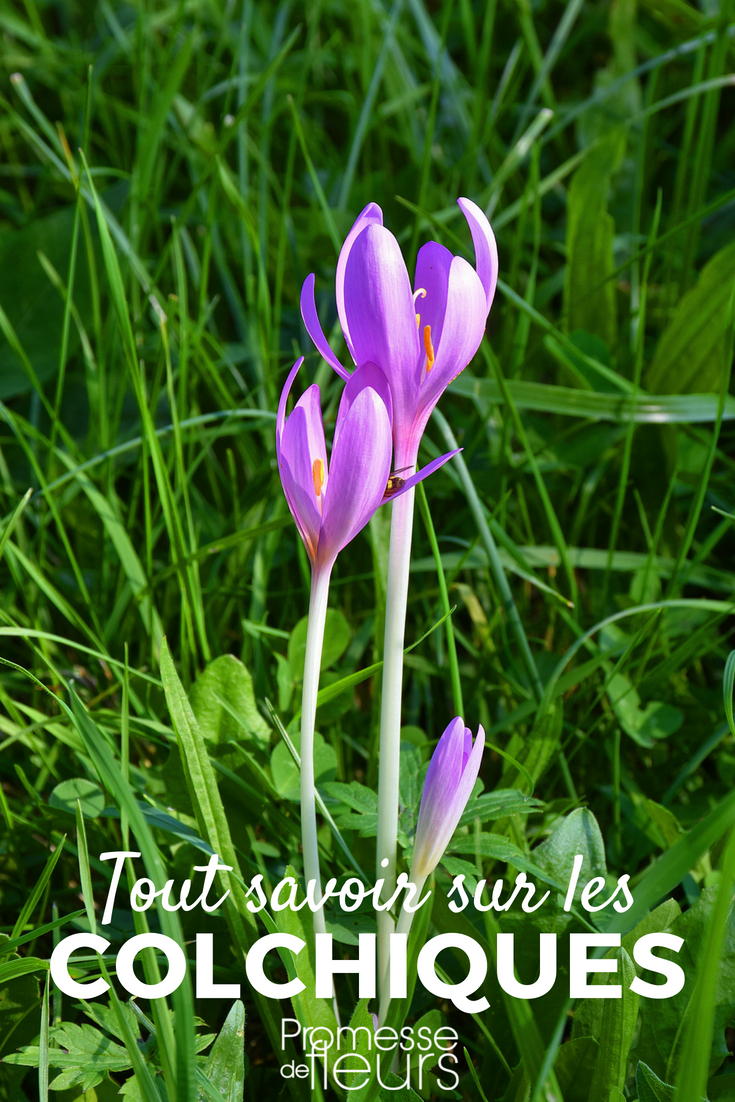































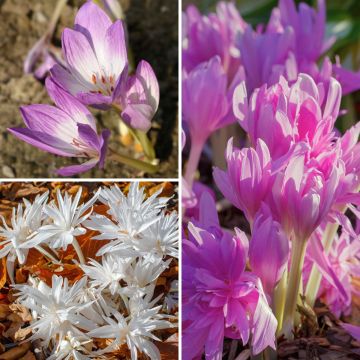
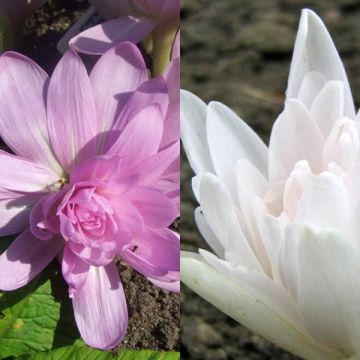

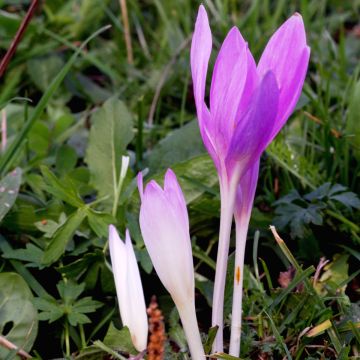
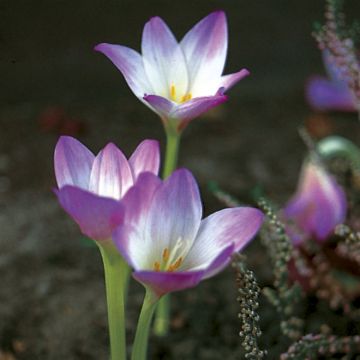
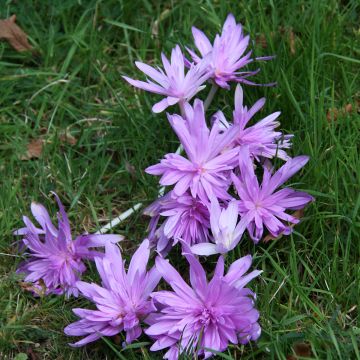
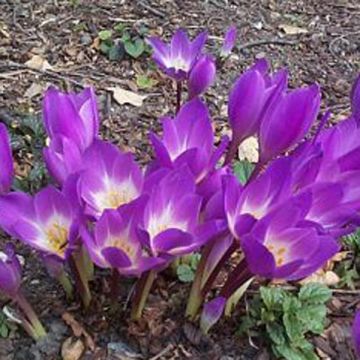
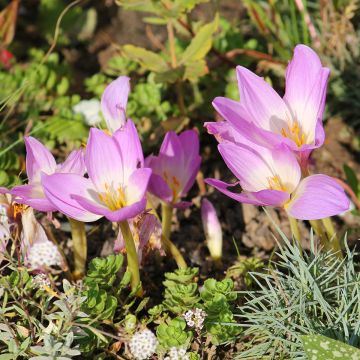


Comments